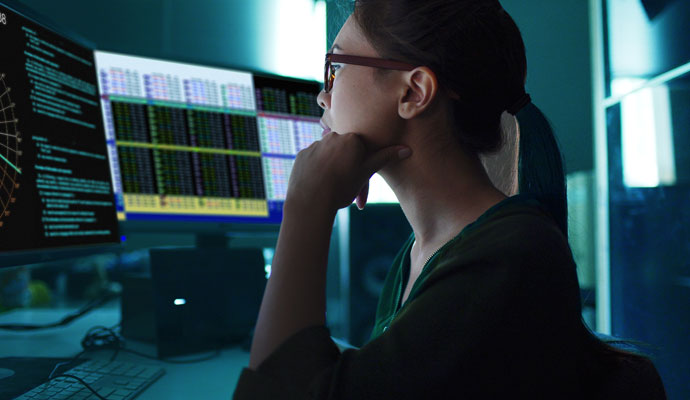Four different ways of knowing
Understanding the world around you can be difficult if you’re constrained by traditional thinking. New approaches to knowledge can help.
The transition to a new decade often brings idealized images of the road ahead, for both companies and industries — and, of course, for the ways in which they should be led. However, as we have entered a 2020 with turbulence in politics, the climate, and markets, we have been offered something equally, if not more, valuable on which to focus: The concept of how we know what we know, and how that knowledge affects the leadership decisions we make.
The academic word for the study of ways of knowing is epistemology. You may have encountered the subject in grad school and then not thought much about it again. If yours was a Western education, perhaps culminating in an MBA, you traversed an instructional path bound by certain assumptions about what is true and what is not — along with acceptable methods for justifying your beliefs. This tradition, particularly in business, emphasizes quantitative, linear reasoning. The requirement for a business case for any new idea in an organization exemplifies the wide acceptance of this way of knowing: Data points A, B, and C lead us to believe that there is a billion-dollar market for our new fitness app.
Like any way of knowing, business case–style reasoning has it has strengths and limitations. When rigorously applied, the process requires articulating assumptions, estimating needs, explaining opportunities and risks, and justifying expectations. However, if you’ve read a handful of business plans, you also may have noticed that it can result in wild speculation and the connection of dots more easily made on paper than in the marketplace.
Like any way of knowing, business case–style reasoning has it has strengths and limitations.
The business-case logic model is particularly well-suited to conditions that are relatively stable. But in times of frequent disruption, novel circumstances abound. Discerning the contours of what is happening — and what is most likely to happen next — can be difficult if you are constrained by traditional thinking.
No single way of knowing is comprehensive. The value of each varies based on the challenge at hand. At a time of rapid change, those who lead effectively will avail themselves of the many paths to wisdom. Here are brief introductions to four ways of knowing that can help break through barriers to understanding both opportunities and risks. These are by no means the only four ways but, in my experience, they are the most useful.
Use systems thinking. Linear models try to understand the whole by breaking it into the smallest possible pieces. To understand how a watch works, you disassemble it, examine the parts, and put it back together again. The relationships between the pieces tends to be simple and static. By contrast, systems thinking attempts to understand the pieces by examining the whole and the relationships and feedback loops that shape it. A systems-based approach to deciding if our fitness app was a viable product would explore all the factors that encourage and discourage fitness: activity patterns, food and nutrition, work and commuting requirements, psychological drivers, cultural norms, and more — as well as the dynamics between them. The most technically sophisticated product may fail if it doesn’t fit well into users’ lives. This is the approach taken by high-end design firms, such as IDEO, which is helping automaker Ford reimagine the future of transportation, and Frog Design, which is bringing forward a new ride-sharing experience for Alto. (For an example of a comprehensive systems approach to global risk, see the 2019 United Nations Global Assessment Report.)
Explore the negative space. A lot of emphasis in organizations is placed on what one knows, particularly in the age of analytics: Data-driven decision making is all the rage. Equally important, however, is articulating what you don’t know. Otherwise, you can fall into the common thinking trap described by psychologist and economist Daniel Kahneman as WYSIATI — what you see is all there is. This cognitive bias restricts your view to what’s right in front of you. When looking for more than incremental change, or when past tweaks have not yielded desired results, try identifying what is in the negative space — what information you don’t have — to broaden that view to include more variables. You’ll become open to more possibilities. Think of the famous optical illusion where you can see both an old woman and a young woman depending on how you assess the positive and negative space in the drawing. Most of us see one or the other, but once we know both are visible, we can see them.
Recall Netflix’s move into streaming video. At first, most investors and industry analysts thought that it wasn’t a viable strategy. CEO Reed Hastings, however, saw the future differently. He looked at what wasn’t there and moved the company toward what he perceived as a distant, though significant and growing, dot on the horizon. Netflix quickly became the dominant player in streaming.
Don’t ask. Observe. The Western tradition of knowing is based on active inquiry. Want to find something out? Ask an expert. Or, more commonly today, type a few words into a search engine. In some North American indigenous cultures, however, such active inquiry is discouraged in favor of patient observation. I learned this in a discussion with Frank Trocco, a scholar with extensive experience with some North American tribes. He told me that elders may recoil from active questions; instead, they cultivate careful relationships with those who hope to acquire knowledge. Much like in an apprenticeship, nuances are discerned through conscientious study and practice. Research by Fikret Berkes and Mina Kislalioglu Berkes suggests that indigenous approaches to knowledge acquisition often look at many variables qualitatively, while Western methods generally examine a few variables quantitatively. The result of the indigenous method is a more holistic understanding of situations.
One way to bring this type of thinking into your leadership decision making is to put down reports and instead spend some time simply watching your customers. This removes the filters that inevitably arise in organizational hierarchies and in the personal preferences and prejudices of those writing the reports. Parker’s is an innovative, award-winning convenience store chain in the southeastern United States. I had the chance to walk through some of those stores with founder, Greg Parker. He shared how spending time in the stores observing human interaction is part of the company’s leadership culture. For example, CTO/CIO Eric Jones and his team spend hours in the store watching how customers interact with cashiers and other employees to understand how they can automate systems to reduce manual tasks and predict customer preferences.
Change your physical environment. Familiar surroundings encourage conventional thinking. To stimulate original insights, disrupt those patterns. Alice Bromage, formerly of the British military and now founder of Empowering Success, takes executives for leadership development outings as diverse as walking the South African bush and swimming with orcas in the Artic. “Each of us has our thinking constrained by boundaries,” she told me. “Often, we don’t even realize that they are there. I take people to places with as few visual boundaries as possible and stretch them in that environment. This lets them intentionally set their own boundaries.” Bromage explained that although she mitigates the risk for participants, it is the adrenalin stimulation of controlled danger that opens executives to learning and self-understanding.
Even if you can’t go on such an exotic journey, you can go to museums, street markets, and other venues that will kindle fresh thinking. Taking a walk can help you see and hear new things, and think differently about the world around you.
No one can know everything. However, everyone can be more perceptive by exploring different techniques for understanding what happens around us. That’s how we begin to build a better world.






